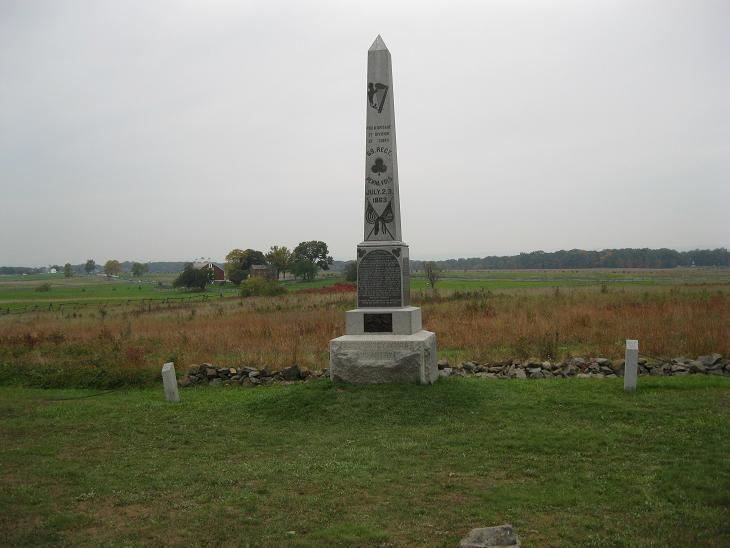Country United States Branch Union Army | Allegiance Union | |
 | ||
Active August 19, 1861 - July 1, 1865 Type Volunteer Infantry Regiment Part of 2nd Brigade, 2nd Division, II Corps, Army of the Potomac | ||
The 69th Pennsylvania Infantry (originally raised as the 2nd California) was a volunteer regiment in the Union army during the American Civil War. Part of the famed Philadelphia Brigade, it played a key role defending against Pickett's Charge during the Battle of Gettysburg. Companies I and K, designated as the regiment's skirmisher companies, wore a very Americanized Zouave uniform. This uniform consisted of a dark blue Zouave jacket with green trimming, green cuffs, and sixteen brass buttons down the front on both sides of the jacket, a sky blue Zouave vest, chasseur sky-blue trousers, and a dark blue kepi. This was one of the few Zouave uniforms that did not use red as the jacket trimming. However, the Zouave uniforms were mostly destroyed during the Peninsula Campaign and were not replaced.
Contents
History
The 69th Pennsylvania was recruited from Philadelphia Irish militia companies of the 2nd Regiment, Pennsylvania Militia. It was mustered into service on August 19, 1861, with Joshua T. Owen as its first colonel. Many of its members had served in the 24th Pennsylvania, a three-month volunteer regiment. The unit was first designated the 2nd California. It left for Washington, D.C. that September, before being assigned to the Army of the Potomac in October as part of Colonel Edwin Baker's California Brigade. The regiment’s first action was at the Battle of Balls Bluff. After this battle, its name was changed to the 68th Penna. for a short time and then the 69th. They made an attempt with the 69th New York to form an Irish Brigade, but Governor Andrew Gregg Curtin of Pennsylvania opposed the idea, which led to the proposal being dropped. The 68th had their regimental designation changed to the 69th in honor of the 69th New York Infantry.
The 69th served in the Peninsula Campaign, during which it was complimented by Maj. Gen. Joseph Hooker for making “the first successful bayonet charge of the war.” Its next major action was at the Battle of Antietam. It lost heavily at the Battle of Fredericksburg, but missed any major action at Chancellorsville, seeing only minor skirmishing.
The unit played a large role at the Battle of Gettysburg, helping repel both Brig. Gen. Ambrose Wright’s charge on July 2 and Pickett's Charge on July 3. Its casualties over the last two days of the battle were enormous, losing 143 men out of 258, including Colonel Dennis O'Kane, Lieutenant Colonel Martin Tschudy, two captains, and a lieutenant. The regiment's ranking officer, Major Duffy, was seriously wounded but refused to give up command until the battle was over. The 69th was the only regiment not to withdraw from defending the stone wall in front of the Copse of Trees during the charge. They were heavily engaged in hand to hand combat; while having been flanked on their right and left flanks as a result of the withdrawal of the two companies from the 71st Pennsylvania Infantry, on their right, and the 59th New York Infantry, on their left. Following the repulse of Pickett, the were numerous Confederate Battle Flags left laying on the field directly to the front of the 69th. The 69th was so devastated by casualties and busy tending to its own wounded while also sending Confederate prisoners to the rear that it failed to secure any. Instead members of regiments who came to assist the 69th with the repulse, during a later point of the assault, went to the 69th's front and claimed the flags as prizes. The 69th finished the campaign under the command of Captain William Davis of Co K.
The 69th fought in Grant’s Overland Campaign, again losing heavily. At the Battle of Spotsylvania Court House, Lieutenant Charles McAnally of Company D captured a Confederate battle flag. He was later awarded the Medal of Honor for this act, becoming the only soldier of the 69th so decorated. After the Battle of Cold Harbor, the 71st Pennsylvania was merged into the 69th. During the Siege of Petersburg, the Philadelphia Brigade was broken up, with the 72nd Pennsylvania mustered out of service and the 106th reduced to a single battalion. The 69th participated in the pursuit of the Army of Northern Virginia during the Appomattox Campaign. The regiment was mustered out at Ball’s Cross-Roads, near Washington, D.C., on July 1, 1865. Of the original 1,000 men mustered into service at the formation of the regiment, only 56 remained at Appomattox.
The 69th was the only Pennsylvania regiment to carry a green "Irish" flag into battle.
Reenactors
The 69th Pennsylvania Irish Volunteers and other reenactment groups portray the regiment at various reenactments. Bus tours and the preservation of sites relating to the 69th also among the group's activities. Additionally, they also have a musical group performing traditional Irish and Civil War music. One of their most important projects is the location of unmarked gravesites of men who fought with the regiment during the Civil War. New gravestones are then placed upon these "final resting places" in a public ceremony. Full information and photos on this year's schedule of events can be found at http://www.pa69irish.com/classic_tan.html.
